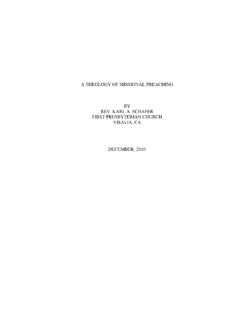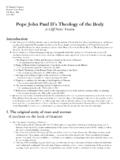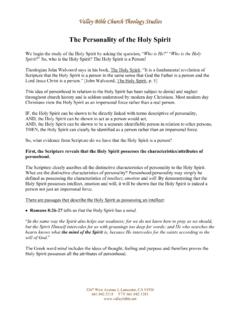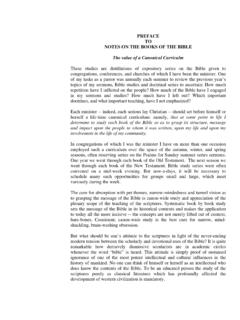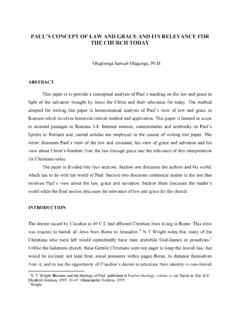Transcription of A Christological Reading of the Shepherd Motif for ...
1 A Christological Reading of the Shepherd Motif for pastoral theology with special reference to Ezekiel 34. Ben Rodgers Sydney, Australia 15th March 2010 1 The Shepherd Motif and pastoral Care 2 PART 1: Exegetical Notes on the Shepherd in Ezekiel 34 3 From Old to New 3 The Old (34:1-10) 4 Broken Covenant 4 The New (34:11-16) 6 New Leadership 6 New Relationship and Community 7 Hope of a New Covenant 7 PART 2: Implications for pastoral Care 10 Christological pastoral Care 13 The pastoral Work of Christ 16 List of References 18 2 The Shepherd Motif and pastoral Care The metaphor of Shepherd is often used to provide a biblical understanding of the functions and role of the pastor. The image of the Shepherd is a powerful metaphor for God s care for His people, and can be quite useful in pastoral care as an example of the character and nature of the compassionate and just God who intimately cares for His people.
2 Psalm 23 and Ezekiel 34 contribute significantly to this Motif . However, caution must be taken as to not simply correlate the work of God described in these passages to the role and function of the pastor in the twenty-first century. The primary concern of the Shepherd metaphor is not a prescription of pastoral functions, but description of God Himself as revealed in the incarnation of Christ as the Good Shepherd (Jn. 10:11); the one Shepherd (Jn. 10:16; Ezek. 34:23; 37:24); the great Shepherd (Heb. 13:20). The metaphor of Shepherd in the Old Testament is generally an anthropomorphic representation of Yahweh. Seward Hiltner, who was influential in constructing a theology of pastoral care, explains his own method in terms of observing the actions of pastoral practitioners. Hiltner placed significance on the empirical description of a pastoral event (Patton 1986, 129) or the data of ministry (Lapsley 1969, 44).
3 He saw the process of pastoral theology being utilised when the practice or functions or events are examined reflectively and thus lead to theory (Hiltner 1958, 22). with a functional hermeneutic method such as this, the passages employing the Shepherd Motif can be used for the purpose of validating the current functions of ministry rather than providing the theological foundation for such ministry. YHWH s description of His own care for His people through the anthropomorphic use of the term Shepherd in passages such as Psalm 23 and Ezekiel 34 has often been used to shape an understanding of pastoral care. When we consider these passages as formative for the role of a pastor, one will soon find that the word Shepherd is problematic (Tidball 1997, 22) and 3 that the image of Shepherd can be pushed so far as to be downright misleading (Liftin 1982, 58-59).
4 Jay Adams (1986, 5-7), for example, draws nine characteristics from the twenty-third Psalm which he claims for the Christian minister defines his work as pastor , concluding that the pastor as a Shepherd , must meet their [the flock s] every need . PART 1 The Shepherd in Ezekiel 34 Approaching the Motif of the Shepherd from an interpretive perspective of biblical theology will give a more accurate presentation of meaning of the text within its context in scripture, and thus a more sound biblical foundation for pastoral theology . with biblical theology being a broad understanding incorporating diverse approaches, it is acknowledged that this discussion of the Shepherd in Ezekiel 34 will not use a specific biblical theology but will incorporate some aspects of a canonical, covenantal, gospel centered, and salvation history perspectives common to biblical theology in providing exegetical notes on Ezekiel 34.
5 From Old to New Chapter 34 of Ezekiel sees in the beginning of a new phase of Ezekiel s prophecy represented by the release of Ezekiel s tongue in the previous chapter (Zimmerli 2003, 91). Ezekiel is no longer restricted to speak of the judgment facing Jerusalem (C. Wright 2001, 223) and the news of the fall of Jerusalem has vindicated the prophet with the fulfillment of his predictions (C. Wright 2001, 223). Von Rad (1968101) observes that three factors bring the prophet s kerygma into being. These are: the new eschatological word with which Yahweh addresses Israel, the old election tradition, and the personal situation . In this chapter the tradition of Yahweh s election of, and covenant(s) with , Israel are clearly present in the text, but the prominent 4 theme is the new word of restoration. Chapter 34, then, begins the section of the book that Block (1998268) entitles in his commentary The Gospel according to Ezekiel.
6 with the restoration of Israel and Judah foretold and Yahweh s purpose of deliverance to bring about a covenant of peace (Ezek. 33:25) is revealed. The Old (34:1-10) Though this chapter reveals the character and purposes of God in deliverance and restoration, it begins with the final climax of the protest against the political leaders (Eichrodt 1970, 471). This is a negative assessment of the leaders of Judah in which a metaphor of shepherds is used. It is a metaphor that is commonly used in Ancient Near Eastern literature as a representation of leadership, royalty, or deity1. In the Old Testament the term Shepherd is generally an anthropomorphic representation of Yahweh2, as we see later in this chapter. However, in the opening ten verses of this chapter, Allen (1990161-164)sees Ezekiel s metaphor as borrowed from Jeremiah 23:1-2 which in referring to shepherds, appears to relate to the last major kings of Judah, Jehoiakim and Zedekiah.
7 In the assessment of the previous situation in Ezekiel 34, the blame is laid firmly on the policies of the last kings of Judah. Broken Covenant The covenantal relationship depicted by the phrase I will be their God and they will be my people 3, is clearly broken. Ezekiel is describing a prior event which has already occurred 1 Laniak (200665-69) presents examples of Mesopotamian gods and rulers as well as Egyptian pharaohs who were referred to with the metaphor of Shepherd . 2 Eg. Ps. 23:1-6; 80:1-2; 95:6-7; Is. 40:10-11; Jer. 23:3; 31:9-11; Ezek. 34:11-31; 37:24; Mich. 5:4-5. The term Shepherd is also used in a negative context to describe the inadequacy of political and spiritual leaders in the Old Testament (Taylor H. 1990, 7), however the passages cited contrast the human efforts with God s perfect care for his sheep (cf.)
8 Jer. 23:1-4; Ezek. 34:1-31). 3 Cf. Gen. 17:8; Jer 24:7; 31:33; 32:38; Ezek. 11:20; 14:11; 37:23-27. 5 (Craige 1983, 242), and is a breakdown in relationship that is testified to by the departure of God s presence from their midst (Ezek. 10:1-22), when Yahweh also pronounced judgment on leaders of Jerusalem (Ezek. 11:1-15). The scattering of the flock (Ezek. 34:5-6) can be related to the preceding exile and injustice of the political and religious leaders in Jerusalem (Blenkinsopp 1990, 157), who neglected their responsibility and abused their authority in seeking their own gain (Ezek. 34:1-4) and will be held accountable (Ezek. 34:10). Through this concept of scattered sheep also finds a further dimension to its understanding in the person of Jesus who has compassion on a people who are like sheep without a Shepherd (Mt. 9:36; Mk 6:34) still awaiting the eschatological reality of the covenant of peace (Ezek.
9 34:25) under the Shepherd promised in Ezekiel 34 (Lane 1974, 226). Likewise God would have compassion on the people of Israel as expressed in the remainder of Ezekiel s oracle concerning restoration. The scattering of the sheep in the exile is an expression of the result of the broken covenant as possession of the land and disobedience towards God s commandment are mutually exclusive (Zimmerli 2003, 54). The covenant has clearly been broken, as Israel was told you must not do as they do in the land of Canaan, where I am bringing you. Do not follow their practices (Lev 18:4). This decree is understood to be incorporated as part the covenant relationship (Lev 26:46 cf. (Sprinkle 2007, 280)), which was clearly broken by the leaders who have turned from Yahweh s decrees and conformed to the standards neighbouring nations (Ezek. 11:12) profaning the holiness of Yahweh who s name they represented to the nations.
10 Due to the holiness of Yahweh and the casuistic nature of certain elements of the covenant, a break in the covenant relationship required a judgment that would have either a punitive or a purging impact (House 1998, 339). Through this judgment Yahweh s lordship over all creation is attested to, in his use of the surrounding nations, the scattering of the 6 flock, the punishment of the leaders, and his sovereign ability to gather his flock from other the whole earth (Ezek. 34:6), nations and countries (Ezek. 34:13), in order to bring them into a new relationship that he will establish. Thus, in addition to judgement, the holiness of God is also a constructive force making new life possible (Brueggemann 1986, 72) in Ezekiel s theology . The New New Leadership (34:11-16) In this new phase of Ezekiel s ministry, the themes that Ezekiel has previously used are still present (House 1998, 340), yet all the emphasis falls on the promise of salvation (Eichrodt 1970, 471) rather than judgment.
